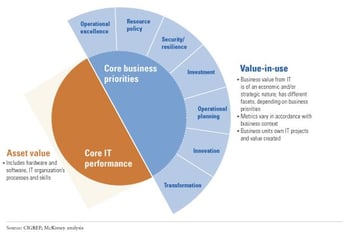Understanding IT Value: How to Measure ROI of IT Transformation
The process of IT transformation (ITX) is long and involved. In most cases, this requires a significant amount of time and resources to set your company up for continued success with a secure, fully digitized system.
As digital transformation is being adopted by all kinds of organizations, the way leaders are thinking about their IT structure is changing dramatically. For example, CIOs used to prioritize cutting costs and data management. However, in the age of IT transformation, that perspective needs to change. Instead of looking to strictly shrink costs, the real focus should be on driving revenue and leveraging the right technologies, people, and processes to achieve big picture goals of the organization.
But there’s a bigger issue at play here: Leadership teams struggle to truly comprehend the actual business value of IT. In fact, 63 percent of CIOs currently struggle to demonstrate IT value to their leaders. So instead of boring the C-suite with details about operations and IT performance, the conversation should be crafted around positioning IT as a revenue generator, not a cost that needs to be reduced.
The Business Value of IT: 2 Factors to Consider
The barriers between IT teams and the rest of the company have stood the test of time for decades. The technical side of everything has always been elusive for those in the organization outside of the IT department.
As CIOs shift their mindset toward driving revenue and playing a major part in the digital transformation within the organization, they should get a grasp on how to properly communicate IT value. As McKinsey points out, this boils down to two key factors:
- Core asset value: This includes those tangible aspects of IT, like the software and hardware used within the organization.
- Value-in-use: This centers on how IT is impacting either the economic or strategic elements of the business, which will depend on the company’s immediate goals.
Fo r example, when businesses invest in new technologies and hardware, that falls under the asset value. As a company increases the speed of IT service operations management, that impacts the business model because it increases profitability of services, which falls under the value-in-use portion.
r example, when businesses invest in new technologies and hardware, that falls under the asset value. As a company increases the speed of IT service operations management, that impacts the business model because it increases profitability of services, which falls under the value-in-use portion.
Both of these levels of IT value complement one another, directly improving the business in many ways. Within the scope of this model, there are many moving parts to consider when calculating the true value of all of these efforts.
Source McKinsey
For example:
- IT transformation projects can directly improve the productivity of teams in various ways, like automating processes and supporting cloud-based big data environments, helping employees gain quick access to the information they need.
- When your IT system enables your employees to act fast with incident and problem management, they can provide services more efficiently, which improves levels of customer satisfaction and the overall customer experience.
- Improving service operations management through IT can lead to faster implementation of new services, giving your company a competitive advantage in the market.
Looking through this lens, you can see how to better tell the story of your IT transformation and how to effectively demonstrate the value of your efforts. This is crucial to the growth of the business, as well as the expansion of your IT operations.
As Gartner’s research predicts, CIOs who can successfully demonstrate IT value to their organization will be able to maintain 60 percent higher funding levels than their peers through 2025. A promising outlook indeed, but what can be done to support CIOs?
It’s time to crunch the numbers and show the return on investment (ROI) through clear data.
How Can I Measure ROI on IT Transformation?
There are a few simple steps to follow, but it’s important to start preparing for ROI measurement before you start implementing your ITX project.
1. Identify Your ITX Goals
As with any initiative, you need to start with clear objectives in mind. What is the destination you want to get to as you develop and follow your digital transformation roadmap?
You might be prioritizing seamless integrations across various platforms, increasing the number of returning customers or referrals, maximizing operational efficiencies, or mitigating fraud losses.
Start with a clear goal, then solidify what the actual outcome should look like.
2. Define Your Business Outcomes
It’s easy to write down focus areas, like improving the customer experience or building a more secure big data system. But the entire team needs to fully understand the actual end goal of your project.
This should be documented and agreed upon throughout all your teams. This way, there’s a clear definition of what success looks like. More importantly, with a clear outcome in mind, you can attribute key performance indicators (KPIs) to this.
3. Choose Your Metrics
You can’t track your progress without measuring the right numbers. This is where KPIs help you steer the direction of your IT transformation project.
Depending on your goals and intended outcomes, you can compile a list of KPIs that directly align with your areas of focus.
For example, if you’re looking to improve the customer experience, you can attribute metrics for IT service management, like average speed of answer, first contact resolution rate, or mean time to resolve. Here are a few examples of other KPIs you can use for your business outcomes:
|
Focus Area of Goal |
Business Outcome |
Examples of KPIs |
|
Customers |
Improved customer experience |
|
|
Operations |
Digitized processes |
|
|
Employees |
Improved employee experience |
|
|
IT infrastructure |
Implementation of secure new systems |
|
With defined goals and outcomes, you’re able to attribute a metric to measure the success of your IT transformation. Make sure you have a reporting process in place to stay in the know of your true ROI.
4. Review and Adjust
With the right reporting strategy, you’re equipped to stay on top of the entire implementation process. If you’re missing your target goals with your KPIs, you can adjust accordingly.
The best way to achieve the ROI you want with ITX is to first invest in the right tools. ServiceNow is a leading enterprise platform that helps companies modernize their operations and processes through various ITX services, including IT service management (ITSM), IT security operations, IT operations management (ITOM), IT asset management (ITAM), and DevOps.
Regardless of the platform you use for ITX, you can gain support and guidance throughout the entire process by collaborating with your ITX software partners in whatever capacity fits your needs and budget, including advisory services or IT managed services.
Ultimately, when you understand how to communicate IT value and can properly measure ROI of your IT transformation, you’re able to gain the trust and buy-in you need from leadership as well as the entire organization. That credibility you demonstrate supports your ultimate goal of driving revenue through your IT efforts to support business growth goals.
Subscribe to Our Blog
Related Posts

The Top 8 Benefits of Using IT Service Management for Your Business

.png?width=176&height=52&name=CA-logo-top%201(1).png)
